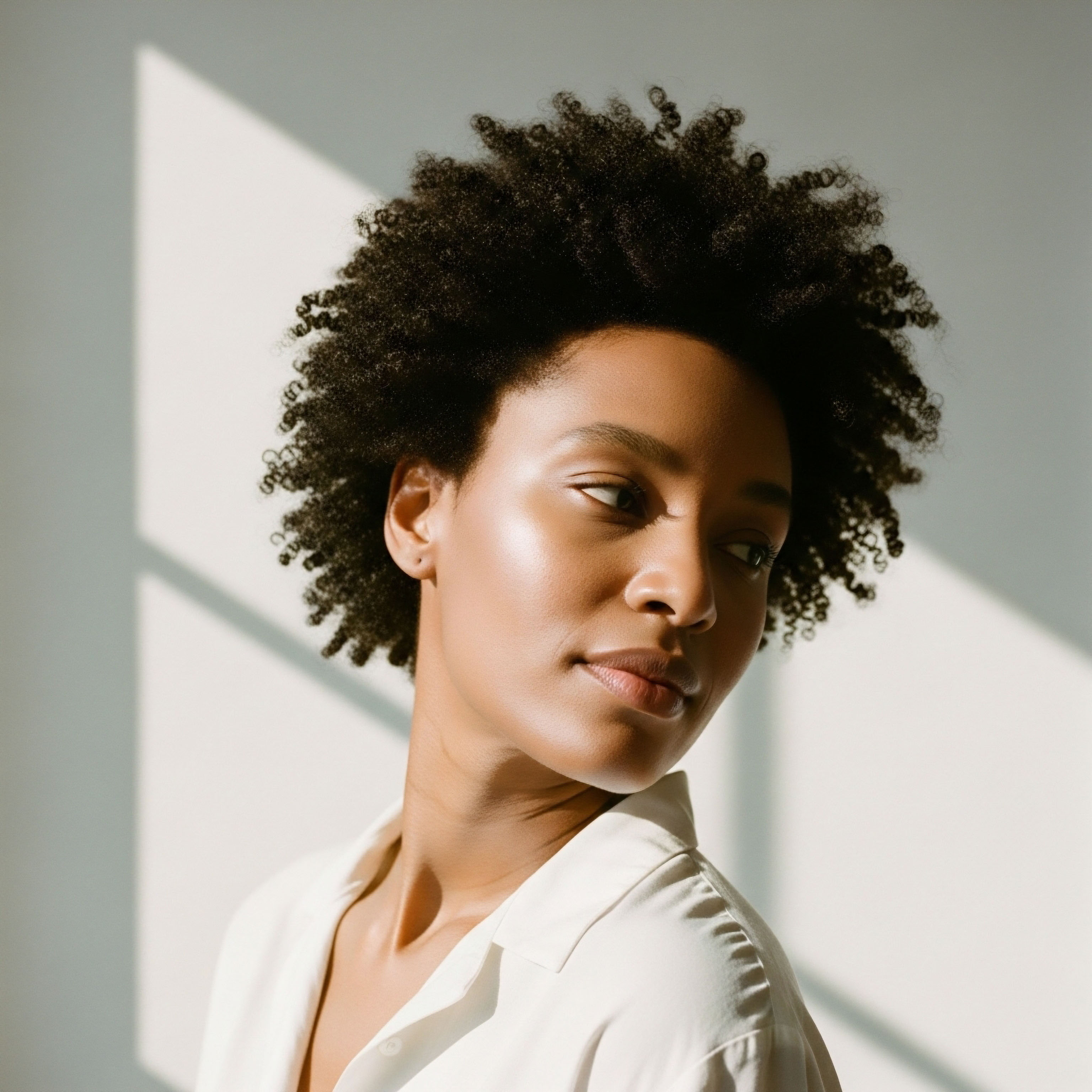

Fundamentals
Perhaps you have noticed a subtle shift in your body’s rhythm, a persistent fatigue that lingers despite adequate rest, or a change in your emotional landscape that feels unfamiliar. These experiences, often dismissed as simply “getting older” or “stress,” can signal a deeper conversation happening within your biological systems.
Your body communicates through an intricate network of chemical messengers known as hormones. When these vital signals become disrupted, even slightly, the ripple effect can touch every aspect of your well-being, from your energy levels and sleep quality to your mood and physical vitality. Understanding these internal dialogues is the first step toward reclaiming your sense of balance and function.
Many individuals seek to restore this balance through personalized wellness protocols, including various forms of hormonal optimization. These therapies aim to recalibrate the body’s natural systems, addressing specific deficiencies or imbalances that contribute to uncomfortable symptoms. However, our daily choices significantly influence the effectiveness of these carefully designed interventions. Among these choices, alcohol consumption stands as a particularly relevant factor, capable of altering the very pathways hormone therapy seeks to support.
Understanding your body’s hormonal signals is a crucial step toward restoring overall well-being.

The Endocrine System and Its Delicate Balance
The endocrine system operates as the body’s internal messaging service, with glands producing and releasing hormones directly into the bloodstream. These hormones then travel to target cells and tissues, instructing them on how to function. Key players include the thyroid gland, adrenal glands, and the gonads (testes in men, ovaries in women), all orchestrated by the hypothalamus and pituitary gland in the brain.
This complex interplay, often described as a series of feedback loops, ensures that hormone levels remain within optimal ranges. When one component is affected, the entire system can experience a cascade of adjustments.
Consider the Hypothalamic-Pituitary-Gonadal (HPG) axis, a central regulatory pathway for reproductive and metabolic health. The hypothalamus releases gonadotropin-releasing hormone (GnRH), which prompts the pituitary gland to secrete luteinizing hormone (LH) and follicle-stimulating hormone (FSH). These gonadotropins then signal the gonads to produce sex hormones like testosterone and estrogen. Any interference at any point along this axis can disrupt the entire chain of command, leading to imbalances that manifest as various symptoms.

Alcohol’s Initial Impact on Body Chemistry
Upon consumption, alcohol, or ethanol, is rapidly absorbed into the bloodstream. The liver, the body’s primary detoxification organ, immediately prioritizes metabolizing this substance. This process involves a series of enzymatic reactions, primarily through alcohol dehydrogenase (ADH) and the microsomal ethanol oxidizing system (MEOS), which convert ethanol into acetaldehyde, a highly toxic compound, and then into acetate. This metabolic diversion has widespread implications for other critical liver functions, including the processing and clearance of hormones.
When the liver is occupied with alcohol detoxification, its capacity to metabolize and excrete endogenous and exogenous hormones is diminished. This can lead to an accumulation of certain hormones or their metabolites, altering their circulating levels and potentially reducing the predictability and effectiveness of any ongoing hormone therapy. This initial metabolic burden sets the stage for more complex hormonal disruptions that can undermine wellness efforts.


Intermediate
For individuals pursuing hormonal optimization protocols, the interaction between alcohol and the body’s intricate biochemical pathways warrants careful consideration. These therapies, whether focused on testosterone recalibration, estrogen balance, or growth hormone support, rely on precise physiological responses. Alcohol, even in moderate amounts, can introduce variables that compromise the intended outcomes, making the journey toward vitality more challenging.

Testosterone Optimization and Alcohol’s Influence
Testosterone replacement therapy (TRT) for men, often involving weekly intramuscular injections of Testosterone Cypionate, aims to restore optimal androgen levels. This protocol frequently includes Gonadorelin to maintain natural testicular function and fertility, and Anastrozole to manage estrogen conversion. Alcohol can directly interfere with these objectives.
Acute alcohol consumption can cause a short-term reduction in testosterone levels by affecting the hypothalamus and pituitary gland, disrupting the signals that prompt testosterone production. Chronic alcohol intake can damage the Leydig cells in the testes, which are responsible for producing testosterone. This damage can lead to a persistent decline in endogenous testosterone synthesis.
For men undergoing TRT, continued heavy drinking can undermine the therapy’s effectiveness, potentially negating the benefits of increased energy, improved mood, and enhanced physical composition. The liver’s prioritization of alcohol metabolism means less efficient processing of exogenous testosterone, leading to unpredictable circulating levels.
Moreover, alcohol can increase the conversion of testosterone into estrogen through a process called aromatization. This is particularly counterproductive for men on TRT, as managing estrogen levels is a key component of many protocols, often addressed with medications like Anastrozole. Elevated estrogen can lead to undesirable side effects such as gynecomastia, fluid retention, and mood disturbances, even while on therapy.
Alcohol consumption can directly counteract the benefits of testosterone replacement therapy by altering hormone metabolism and increasing estrogen conversion.

Female Hormonal Balance and Alcohol’s Impact
Women seeking hormonal balance, particularly those navigating peri-menopause or post-menopause with therapies like Testosterone Cypionate subcutaneous injections or Progesterone, also face specific challenges with alcohol. These protocols are designed to alleviate symptoms such as irregular cycles, mood fluctuations, hot flashes, and diminished libido. Alcohol can exacerbate many of these very symptoms.
Alcohol consumption can significantly influence estrogen metabolism. The liver’s diversion to process alcohol can impede its ability to clear excess estrogen, potentially leading to higher circulating estrogen levels. This effect is particularly pronounced in women using synthetic estrogens. Conversely, some studies indicate that alcohol can decrease progesterone levels, a hormone critical for menstrual cycle regularity, mood stability, and reproductive health.
This dual impact ∞ potentially increasing estrogen while decreasing progesterone ∞ can worsen hormonal imbalances and intensify menopausal symptoms like hot flashes, night sweats, and anxiety.
For women utilizing Anastrozole as part of their hormonal strategy, often to reduce estrogen levels, the direct interaction with alcohol is generally considered minimal. However, alcohol can independently trigger symptoms like hot flashes, which might be mistaken for a therapy side effect or simply worsen existing ones.

Growth Hormone Peptides and Alcohol
Growth hormone peptide therapies, involving agents such as Sermorelin, Ipamorelin / CJC-1295, and Tesamorelin, aim to stimulate the body’s natural production of growth hormone (GH) and insulin-like growth factor 1 (IGF-1). These peptides are often sought for their potential benefits in anti-aging, muscle gain, fat loss, and sleep improvement.
Alcohol consumption can negatively affect the secretion of growth hormone. Studies indicate that alcohol can inhibit spontaneous pulsatile GH secretion, thereby reducing its overall effectiveness. This means that the carefully administered peptides might not yield their full therapeutic potential if alcohol is regularly consumed. Furthermore, some side effects of peptide therapy, such as headaches or dizziness, can overlap with those of alcohol, potentially intensifying discomfort.

Other Targeted Peptides and Alcohol Considerations
Beyond growth hormone secretagogues, other specialized peptides like PT-141 for sexual health or Pentadeca Arginate (PDA) for tissue repair are part of personalized wellness protocols. While direct studies on alcohol’s interaction with every specific peptide are limited, the general principle remains ∞ alcohol places a metabolic burden on the body and can disrupt various physiological processes.
This disruption could indirectly affect the efficacy of these peptides, which rely on optimal bodily function for their therapeutic actions. For instance, PT-141’s action on the central nervous system for sexual arousal could be influenced by alcohol’s depressant effects. PDA’s role in healing and inflammation might be hindered by alcohol’s pro-inflammatory properties and its impact on cellular repair mechanisms.
The table below summarizes some key interactions between alcohol and common hormone therapy components:
| Hormone Therapy Component | Primary Therapeutic Goal | How Alcohol Can Interfere |
|---|---|---|
| Testosterone Cypionate (Men) | Restore androgen levels, improve vitality | Increases estrogen conversion, burdens liver metabolism, suppresses natural testosterone production. |
| Testosterone Cypionate (Women) | Balance hormones, alleviate symptoms | Can increase circulating estrogen, potentially worsening symptoms or creating imbalance. |
| Progesterone | Support menstrual cycle, mood, reproductive health | May decrease progesterone levels, exacerbating hormonal imbalance. |
| Anastrozole | Reduce estrogen conversion | Generally minimal direct interaction, but alcohol can independently worsen hot flashes. |
| Gonadorelin | Maintain natural hormone production, fertility | Potential for altered drug action or increased side effects; general caution advised. |
| Sermorelin / Ipamorelin | Stimulate growth hormone release | Can negatively impact natural growth hormone secretion, reducing peptide effectiveness. |
| Clomid / Tamoxifen | Restore HPG axis function, manage estrogen | May worsen side effects, reduce drug absorption/metabolism, increase estrogen. |


Academic
The interplay between alcohol consumption and endocrine function extends far beyond simple metabolic competition, reaching into the intricate molecular and cellular mechanisms that govern hormonal synthesis, transport, receptor sensitivity, and degradation. A deep understanding of these interactions reveals why alcohol presents a significant challenge to optimizing hormonal health and achieving desired therapeutic outcomes.

Hepatic Metabolism and Hormonal Homeostasis
The liver serves as a central hub for both alcohol detoxification and hormone metabolism. When ethanol is consumed, the liver prioritizes its breakdown through the alcohol dehydrogenase (ADH) and cytochrome P450 2E1 (CYP2E1) pathways. This process generates reactive oxygen species and alters the cellular redox state, specifically increasing the NADH/NAD+ ratio.
This shift has profound implications for steroid hormone synthesis and catabolism. For instance, the conversion of cholesterol to steroid hormones, and the subsequent interconversion of various steroid forms, rely on specific enzymes that are sensitive to the cellular redox environment. An altered NADH/NAD+ ratio can impair these enzymatic activities, leading to dysregulation of hormone production and clearance.
Beyond direct enzymatic interference, chronic alcohol exposure can induce liver damage, ranging from steatosis to cirrhosis. A compromised liver has a diminished capacity to conjugate and excrete hormones, leading to their accumulation in circulation. This is particularly relevant for estrogens, which undergo extensive hepatic metabolism.
Elevated circulating estrogen levels, whether endogenous or exogenous from hormone therapy, are associated with increased risks for certain hormone-sensitive cancers, such as breast cancer. The combination of hormone therapy and alcohol consumption can synergistically increase these risks, as demonstrated by studies showing a markedly higher risk of breast cancer when alcohol is combined with hormone therapy.

Disruption of the Hypothalamic-Pituitary-Gonadal Axis
Alcohol exerts a multi-level disruptive effect on the HPG axis, the master regulatory system for reproductive hormones.
- Hypothalamic Level ∞ Alcohol can suppress the pulsatile release of gonadotropin-releasing hormone (GnRH) from the hypothalamus. GnRH is the primary signal that initiates the cascade of sex hormone production. Studies indicate that alcohol can increase hypothalamic beta-endorphin, an opioid peptide that inhibits GnRH secretion.
- Pituitary Level ∞ Reduced GnRH signaling, coupled with direct effects of alcohol, can lead to decreased secretion of luteinizing hormone (LH) and follicle-stimulating hormone (FSH) from the pituitary gland. LH is critical for stimulating testosterone production in Leydig cells, while FSH supports spermatogenesis in men and follicular development in women.
- Gonadal Level ∞ Alcohol has direct toxic effects on the gonads. In men, chronic alcohol exposure can damage Leydig cells, impairing their ability to synthesize testosterone in response to LH. In women, alcohol can interfere with ovarian function, affecting follicular development and ovulation, which can lead to menstrual irregularities and reduced progesterone production.
This systemic disruption of the HPG axis means that even when exogenous hormones are administered as part of therapy, the body’s intrinsic regulatory mechanisms are compromised, making it harder to achieve and maintain stable, physiological hormone levels.

Alcohol’s Influence on Adrenal and Thyroid Axes
Beyond the HPG axis, alcohol impacts other crucial endocrine systems. The hypothalamic-pituitary-adrenal (HPA) axis, responsible for the stress response, is highly sensitive to alcohol. Acute alcohol exposure activates the HPA axis, leading to an increase in circulating adrenocorticotropic hormone (ACTH) and glucocorticoids, such as cortisol.
While acute effects can be stimulatory, chronic alcohol consumption can lead to HPA axis dysregulation, potentially contributing to adrenal fatigue and altered cortisol rhythms. Elevated cortisol can, in turn, suppress other hormonal pathways, including the HPG axis, further complicating hormonal balance.
The hypothalamic-pituitary-thyroid (HPT) axis, which regulates metabolism, can also be affected. Alcohol can interfere with thyroid hormone production and conversion, potentially leading to subclinical hypothyroidism or impaired metabolic rate. This can manifest as fatigue, weight gain, and difficulty regulating body temperature, symptoms that often overlap with hormonal imbalances and can be exacerbated by alcohol.

Molecular Mechanisms of Interference
At a molecular level, alcohol and its metabolites, particularly acetaldehyde, can directly interfere with cellular signaling pathways. Acetaldehyde can form adducts with proteins and DNA, leading to cellular damage and impaired enzyme function. This includes enzymes involved in hormone synthesis, transport proteins, and even hormone receptors. For example, alcohol can alter the sensitivity of hormone receptors, meaning that even if hormone levels are optimized through therapy, the target cells may not respond effectively.
Alcohol also influences neurotransmitter systems in the brain, such as dopamine and opioid pathways, which are intimately linked with hormonal regulation. Changes in these systems can affect mood, libido, and the central control of hormone release. For instance, increased beta-endorphin levels due to alcohol can suppress GnRH and LH, as previously noted.
The following table illustrates the multifaceted impact of alcohol on various hormonal axes and related metabolic processes:
| Hormonal Axis / System | Primary Function | Specific Alcohol-Induced Disruption | Clinical Implication for Therapy |
|---|---|---|---|
| HPG Axis | Regulates sex hormone production (Testosterone, Estrogen, Progesterone) | Suppresses GnRH, LH, FSH release; damages gonadal cells; increases aromatization. | Reduced efficacy of TRT/HRT; unpredictable hormone levels; worsened symptoms. |
| HPA Axis | Manages stress response (Cortisol) | Activates acutely, dysregulates chronically; increases cortisol levels. | Increased anxiety, fatigue; interference with other hormonal pathways. |
| HPT Axis | Controls metabolism (Thyroid hormones) | Interferes with thyroid hormone production and conversion. | Metabolic slowdown; exacerbated fatigue and weight changes. |
| Liver Metabolism | Processes hormones, detoxifies substances | Prioritizes alcohol, impairs hormone clearance; increases estrogen accumulation. | Fluctuating hormone levels; increased risk of side effects, including certain cancers. |
| Insulin Sensitivity | Regulates blood sugar (Insulin) | Can lead to insulin resistance. | Metabolic dysfunction; weight gain; impaired energy regulation. |

How Does Alcohol Consumption Affect the Efficacy of Peptide Therapies?
Peptide therapies, particularly those targeting growth hormone release, such as Sermorelin or Ipamorelin/CJC-1295, rely on the body’s ability to respond to specific signaling molecules. Alcohol can directly interfere with the neuroendocrine pathways that regulate growth hormone secretion. For example, alcohol has been shown to inhibit the spontaneous pulsatile release of growth hormone from the pituitary gland.
This means that even if a peptide is administered to stimulate GH release, the presence of alcohol could blunt the physiological response, reducing the overall therapeutic benefit. The mechanisms involve alcohol’s effects on hypothalamic somatostatin and growth hormone-releasing hormone (GHRH) neurons, which control GH secretion.
Furthermore, the downstream effects of growth hormone, such as the production of insulin-like growth factor 1 (IGF-1) in the liver, can also be compromised. If the liver is burdened by alcohol metabolism, its capacity to synthesize IGF-1 in response to GH signals may be reduced. This can diminish the anabolic and regenerative effects sought through peptide therapy, impacting muscle growth, fat metabolism, and tissue repair.

What Are the Long-Term Consequences of Combining Alcohol with Hormone Therapy?
The long-term consequences of combining alcohol with hormone therapy extend beyond immediate symptom exacerbation or reduced treatment efficacy. Chronic alcohol consumption can lead to sustained physiological adaptations that make hormonal balance increasingly difficult to achieve. Persistent liver strain can result in irreversible damage, further impairing hormone metabolism and increasing the risk of complications.
The continuous disruption of the HPG, HPA, and HPT axes can lead to chronic endocrine dysfunction, potentially requiring higher doses of therapy or more complex protocols to manage symptoms.
For women, the elevated estrogen levels associated with alcohol consumption, especially when combined with exogenous hormone therapy, raise concerns about long-term breast cancer risk. For men, chronic alcohol-induced hypogonadism can become more entrenched, making it harder to restore natural testosterone production even after discontinuing alcohol.
The systemic inflammatory effects of alcohol can also contribute to chronic disease states, undermining the overall health and longevity goals often associated with personalized wellness protocols. The cumulative effect is a body struggling to maintain equilibrium, despite therapeutic interventions, leading to a diminished quality of life and increased vulnerability to various health challenges.

References
- Chen, W. Y. et al. “Alcohol and Hormone Therapy Increase the Risk of Breast Cancer.” Annals of Internal Medicine, vol. 137, no. 10, 2002, pp. 798-804.
- Emanuele, M. A. et al. “Alcohol and the Male Reproductive System.” Alcohol Health and Research World, vol. 21, no. 3, 1997, pp. 195-201.
- Gill, J. “The Effects of Moderate Alcohol Consumption on Female Hormone Levels and Reproductive Function.” Alcohol and Alcoholism, vol. 35, no. 5, 2000, pp. 417-423.
- Ginsburg, E. S. et al. “The Effects of Moderate Alcohol Consumption on Female Hormone Levels and Reproductive Function.” Alcohol and Alcoholism, vol. 35, no. 5, 2000, pp. 417-423.
- Mendelson, J. H. et al. “Acute Effect of Alcohol on Estradiol, Estrone, Progesterone, Prolactin, Cortisol, and Luteinizing Hormone in Premenopausal Women.” Journal of Pharmacology and Experimental Therapeutics, vol. 245, no. 3, 1988, pp. 877-882.
- Rachdaoui, N. and Sarkar, D. K. “Effects of Alcohol on the Endocrine System.” Endocrinology and Metabolism Clinics of North America, vol. 41, no. 3, 2012, pp. 543-552.
- Sarkola, T. et al. “Acute Effect of Alcohol on Estradiol, Estrone, Progesterone, Prolactin, Cortisol, and Luteinizing Hormone in Premenopausal Women.” Journal of Pharmacology and Experimental Therapeutics, vol. 245, no. 3, 1988, pp. 877-882.
- Soszynski, P. A. and Frohman, L. A. “Chronic Alcohol Consumption Reduces Growth Hormone Receptor mRNA in Rat Liver.” Endocrinology, vol. 131, no. 1, 1992, pp. 261-266.
- Speroff, L. “Alcohol and Hormone Therapy Increase the Risk of Breast Cancer.” Clinical Briefs in Primary Care Supplement, 2002.
- Teoh, S. K. et al. “The Effects of Moderate Alcohol Consumption on Female Hormone Levels and Reproductive Function.” Alcohol and Alcoholism, vol. 35, no. 5, 2000, pp. 417-423.

Reflection
Your personal health journey is a dynamic process, a continuous dialogue between your biological systems and the choices you make each day. The insights shared here regarding alcohol’s influence on hormonal health and therapeutic outcomes are not meant to prescribe a rigid path, but rather to illuminate the intricate connections within your body. Understanding how external factors interact with your internal biochemistry provides you with the knowledge to make informed decisions that align with your goals for vitality and function.
Consider this information as a compass, guiding you toward a deeper appreciation of your unique biological blueprint. The path to optimal well-being is highly individualized, and what serves one person may not serve another in precisely the same way.
Armed with this understanding, you are better equipped to engage in meaningful conversations with your healthcare providers, tailoring protocols and lifestyle adjustments to your specific needs. Your capacity to reclaim and sustain robust health rests upon this foundation of self-awareness and proactive engagement.

Considering Your Wellness Path
Each decision you make, from dietary choices to stress management techniques, contributes to the symphony of your endocrine system. Recognizing alcohol’s potential to disrupt this delicate balance is a powerful realization. It prompts a moment of introspection ∞ are your habits truly serving your highest health aspirations? This question invites a thoughtful response, one that honors your desire for well-being without judgment.
The journey toward hormonal optimization is a partnership ∞ a collaboration between your innate biological intelligence and targeted, evidence-based interventions. Your commitment to understanding your body’s responses, observing subtle shifts, and adjusting your approach accordingly is paramount. This ongoing process of learning and adaptation is where true, lasting vitality is found.



